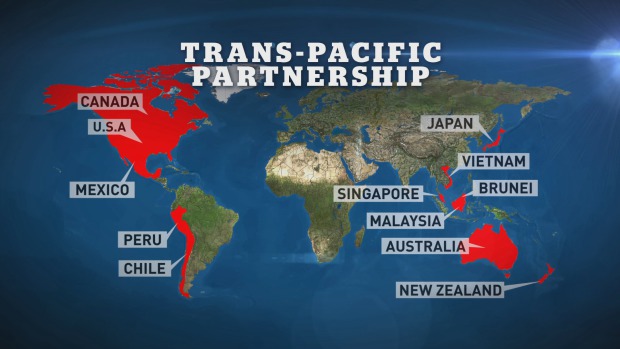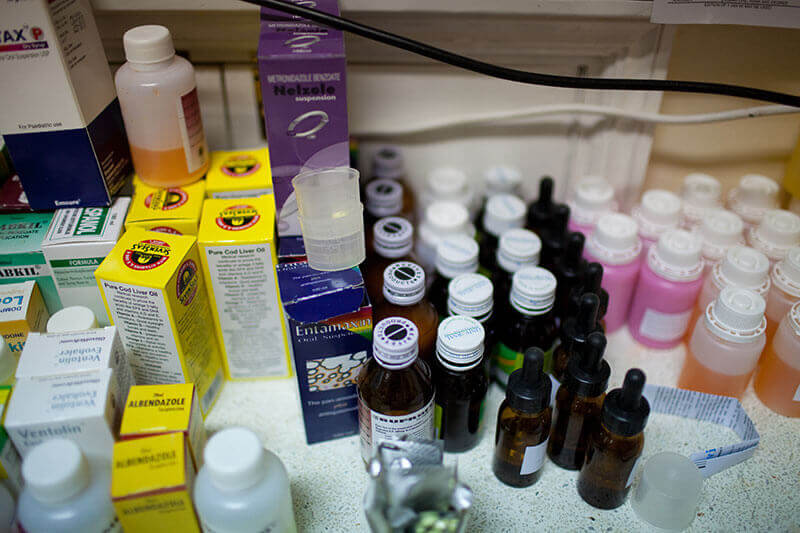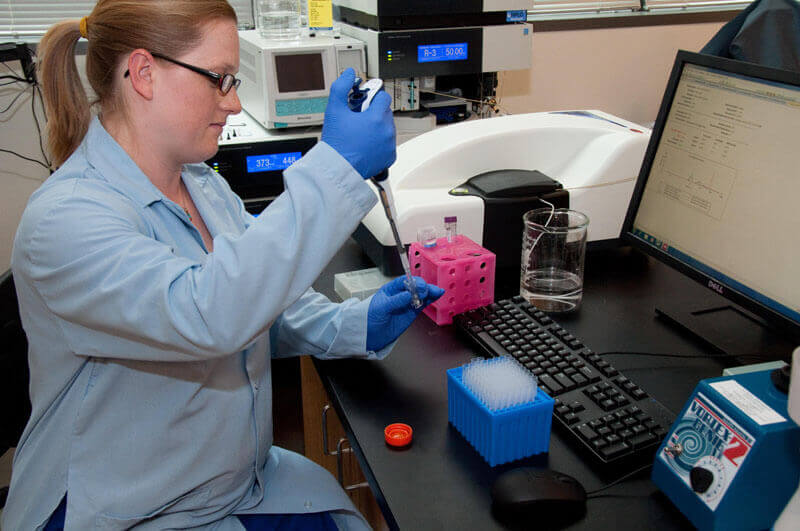Courtney CarsonGHTC
Courtney Carson is a policy and advocacy officer at GHTC, who leads GHTC's US advocacy portfolio.
 TPP countries. Photo: CBCAfter ten years of debate, on November 5, 2015, international negotiators released the final text of the largest regional trade agreement in history—the
Trans Pacific Partnership (TPP). This trade deal between the United States and 11 other Pacific Rim countries (Australia, Brunei, Canada, Chile, Japan,
Malaysia, Mexico, New Zealand, Peru, Singapore, and Vietnam) links 40 percent of the world’s economy, dramatically reduces tariffs, and establishes
high standards for labor, environmental, and intellectual property (IP) protections—including enhanced protections on pharmaceutical products.
TPP countries. Photo: CBCAfter ten years of debate, on November 5, 2015, international negotiators released the final text of the largest regional trade agreement in history—the
Trans Pacific Partnership (TPP). This trade deal between the United States and 11 other Pacific Rim countries (Australia, Brunei, Canada, Chile, Japan,
Malaysia, Mexico, New Zealand, Peru, Singapore, and Vietnam) links 40 percent of the world’s economy, dramatically reduces tariffs, and establishes
high standards for labor, environmental, and intellectual property (IP) protections—including enhanced protections on pharmaceutical products.
Why does TPP matter for global health?
IP protections for health products can be a double-edged sword. They help to encourage innovation and spur the development of new drugs, tools, and other health technologies by temporarily providing exclusive rights to sell or market a product—allowing developers to recover expensive upfront investments in research and development (R&D). Without this promise of protection, companies might be skeptical to invest in new R&D for fear a competitor could steal their trade secret and sell a similar product, undercutting their profit. At the same time, many public health advocates believe that when IP protections are too strong, they impede access to affordable medicine. In this case, the health care costs of delaying introduction of affordable generic medication could outweigh the benefits of incentivizing innovation.
When the 1994 World Trade Organization agreement on Trade-Related Aspects of Intellectual Property Rights (TRIPS) was negotiated, parties sought to strike a balance between promoting public health and encouraging health-related innovation. TRIPS set a global minimum of 20-year patent protection for pharmaceutical products, while at the same time affirming the rights of countries to take measures to protect public health and promote access to medicines for all. This included designating public health crises as national emergencies, in which countries can override IP protections, and allowing least-developed countries a 10-year on-ramp period to introduce patent protections.
As TPP’s provisions were negotiated behind the scenes, many public health advocates feared that the agreement would go far beyond TRIPS standards and establish a new high-water mark for pharmaceutical patent and data protections that would become the minimum standard for future trade deals. Now that the official text has been released publicly, we can see the results of the negotiations.
What’s in TPP?
Below I break down IP protections in TPP, describe their potential impact on health technologies, and discuss how these provisions compare to the changes speculated.
Patents for new uses of an existing product
 Photo: PATH/Eric BeckerWhat would TPP do?
Photo: PATH/Eric BeckerWhat would TPP do?
“confirms that patents are available for inventions claimed as at least one of the following: new uses of a known product, new methods of using a known product, or new processes of using a known product.”
Why is this concerning? How did negotiations shake out?
Under TRIPS, countries can choose to exclude new uses of existing products from patentability. TPP (and other trade deals negotiated after the 1994 TRIPS agreement) allows “evergreening” across all technologies and does not single out pharmaceuticals. While public health advocates feared TPP would include a new provision explicitly prohibiting countries from implementing an enhanced efficacy requirement for “evergreen”-type patents, it is not included in the final text and therefore efficacy requirements remain the individual decision of each party country.
Patent term extensions
What would TPP do?
“provide the means to…adjust the term of [a] patent to compensate for delays” in patent approval.
“with respect to a pharmaceutical product that is subject to a patent…make available an adjustment of the patent term to compensate the patent owner for unreasonable curtailment of the effective patent term as a result of the marketing approval process.”
Why is this concerning? How did negotiations shake out?
TRIPS does not specify what constitutes “unreasonable delay.” Advocates feared TPP would go beyond standards set by other trade agreements and lessen the time companies could claim an ureasonable delay for patent approval to four years from filing and two years from request for examination. Instead, TPP maintains the status quo at five years and three years respectively, with no definition of unreasonable delay in granting marketing access.
Data exclusivity
 Photo: PATH/Patrick McKernWhat would TPP do?
Photo: PATH/Patrick McKernWhat would TPP do?
Provide five years data exclusivity for pharmaceutical products if “the submission of undisclosed test or other data concerning the safety and efficacy of the product” is required “as a condition for granting marketing approval.”
Provide three years data protection “with respect to new clinical information submitted as required in support of a marketing approval of a previously approved pharmaceutical product covering a new indication, new formulation or new method of administration.”
Why is this concerning? How did negotiations shake out?
Data exclusivity, in effect, extends the life of a patent because, most often, generic manufacturers cannot afford to conduct their own duplicate clinical trials and tests. This means that generic manufacturers must wait until data exclusivity has expired before they can use branded data to justify the safety or efficacy of their product and introduce it into the market. Data exclusivity is not discussed in TRIPS, and while previous trade agreements have included data exclusivity for new pharmaceutical products, TPP is the first agreement to extend data exclusivity to new uses of existing products.
Biologics
What would TPP do?
“provide effective market protection through…protection of undisclosed test or other data…for a period of at least eight years from the date of first marketing approval of that product.
OR
“provide effective market protection through… protection of undisclosed test or other data…for a period of at least five years” and “through other measures.”
Why is this concerning? How did negotiations shake out?
Biologics are a new class of pharmaceutical product that hold tremendous promise for hard-to-treat diseases and conditions. Since the technology is so new, it is uncertain how patent terms and data exclusivity will impact the scale-up and roll-out of this new class of drugs. Because this technology was unknown in 1994, biologics were not included in TRIPS. Each country party to TPP has established different IP protections on biologics—ranging from twelve years data exclusivity in the United States, to eight years in Japan, to five years in Australia, to no protection at all in Vietnam.
Public health advocates were concerned that US pharmaceutical companies were behind the United States’ push for 12-year data exclusivity for biologics in TPP, mirroring provisions in the Affordable Care Act. Other nations, led by Australia, Chile, and Peru, strongly opposed a twelve-year term because delaying the introduction of biosimilars could increase the cost of medicine and strain public health systems. After contentious negotiations that threatened to derail the entire trade deal, a compromise was reached: TPP countries can chose to provide a minimum of eight years of data protection for biologics or a minimum five years of protection combined with “other measures” of protection.
What’s next?
While some IP elements in TPP remain concerning for public health advocates, negotiations did not expand IP protections for pharmaceuticals as much as many had feared. In addition, TPP includes language reaffirming commitment to the Declaration on TRIPS and Public Health stating:
“The obligations of [the IP] Chapter do not and should not prevent a Party from taking measures to protect public health.”
Still, there is reason to closely monitor this trade agreement as it is considered for ratification in each of the twelve member states. High-level officials from the World Health Organization worry that TPP represents corporations influencing decision-making in health policy, and groups like Médecins Sans Frontières state that, “Although the text has improved over the initial demands, the TPP will still go down in history as the worst trade agreement for access to medicines in developing countries.”
On the other end of the spectrum, Senator Orrin Hatch (R-UT) who leads the Senate Finance Committee—key to passing TPP through Congress—is “concerned that, particularly with regard to intellectual property, the administration may not have gotten the best deal possible” and should return to the negotiating table. While TPP doesn’t change US law on biologics, he remains concerned unequal treatment abroad may prohibit US companies from recouping the costs of investment.
President Obama signaled his intent to sign TPP when the Administration released the agreement’s text on November 5th. Per statute, there must be at least 60 days for public review and comment before the President can sign, and the Administration has pledged to extend the comment period to 90 days. Next the President will send legislation authorizing implementation of TPP to Congress, where members will have a maximum of 90 days to approve or disapprove of the trade deal, without amendment.
Even if TPP is ratified, there will be a significant transition period before all regulations go into effect—it could take decades to implement some provisions in developing country signatories like Vietnam. In this way, the full impact of TPP on access to medicine will not be realized for years to come. It is important that the global health community continue to monitor this deal and push for trade agreements that appropriately balance protections for IP with protections to public health and access to medicine.IP
Courtney Carson is GHTC’s senior policy and advocacy associate.